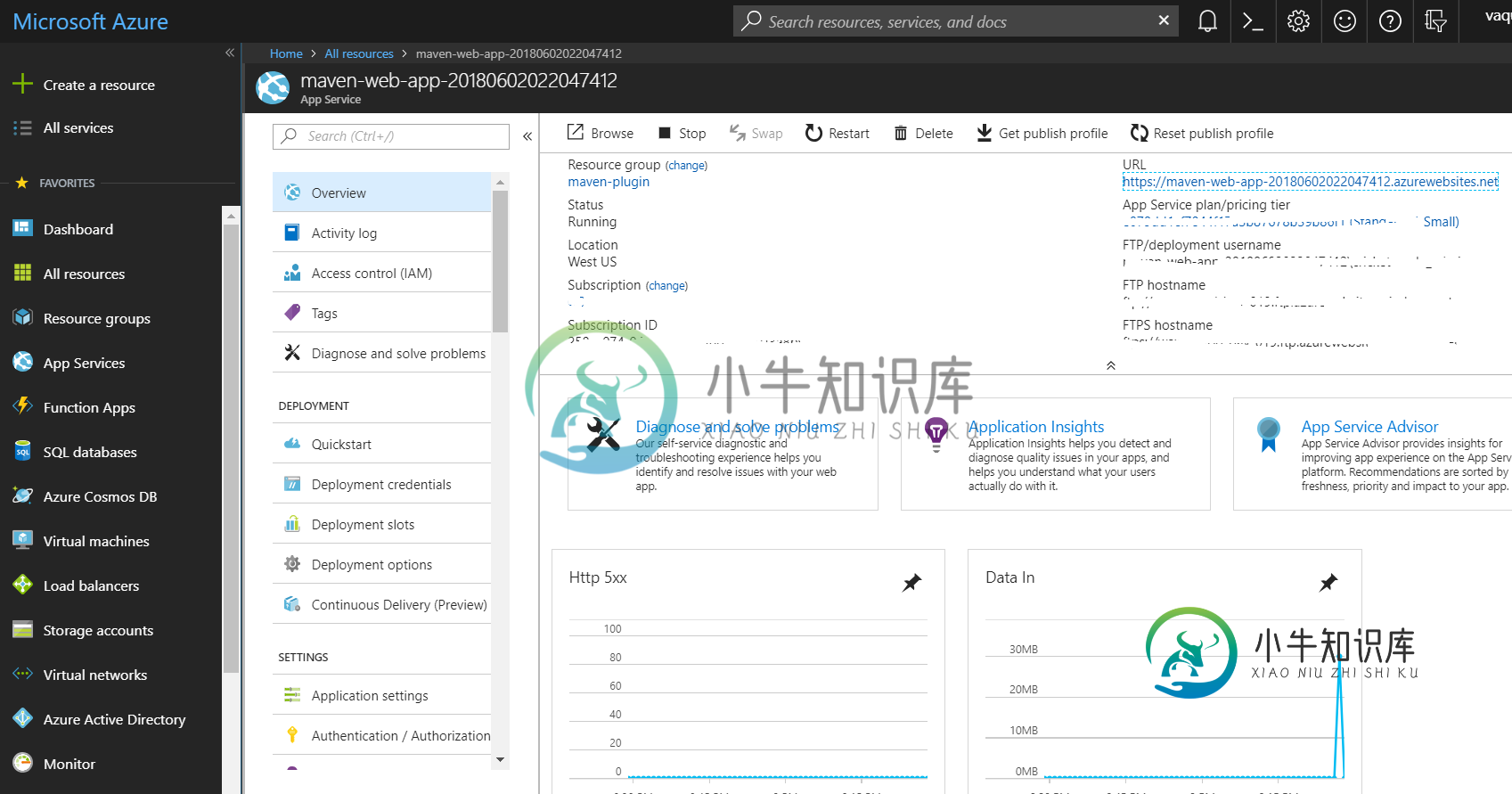在Azure App Service上部署Spring Boot jar
我在获取 Spring 启动 API 以在 Azure 应用服务上运行时遇到问题。我一直在 https://learn.microsoft.com/en-us/java/azure/spring-framework/deploy-spring-boot-java-web-app-on-azure 上遵循微软指南,但到目前为止还没有运气。
应用程序确实启动了(我可以在日志文件中看到应用程序启动),但是对应用程序服务url的http请求总是超时。
我读过 Azure 应用服务只拾取在端口 80 或 8080 上运行的嵌入式雄猫服务器,但也没有运气。
该应用程序部署在www根目录和适当的web中。config也已部署。
我尝试过在有或没有应用程序服务器的情况下运行应用程序服务(Tomcat和Jetty,这是不需要的,因为服务器嵌入在应用程序中),但两种方法都失败了。
我是否缺少其他配置部分?或者这可能与我在azure上使用的计划类型有关?也许资源有问题?
有什么指示吗?
感谢
伯特
共有3个答案
结合官方教程中的步骤和您的实际情况,我提供以下检查点:
要点1:请使用mvn包在pom所在的目录中构建JAR包。找到xml文件。
第2点:请确保web.config中配置的jar包名称与上传的jar包名称相同。
web.config
<?xml version="1.0" encoding="UTF-8"?>
<configuration>
<system.webServer>
<handlers>
<add name="httpPlatformHandler" path="*" verb="*" modules="httpPlatformHandler" resourceType="Unspecified" />
</handlers>
<httpPlatform processPath="%JAVA_HOME%\bin\java.exe"
arguments="-Djava.net.preferIPv4Stack=true -Dserver.port=%HTTP_PLATFORM_PORT% -jar "%HOME%\site\wwwroot\<your project name>"">
</httpPlatform>
</system.webServer>
</configuration>
要点 3:请使用 FTP 将 jar 文件和 web.config 发布到 KUDU 上的 D:\home\site\wwwroot\ 目录。
第4点:请确保< code>ApplicationSettings与您的项目相匹配,例如< code>jdk版本、< code>tomcat版本。
如果要部署war文件,需要在Azure门户上配置应用程序服务的ApplicationSettings,然后将war文件上载到路径D:\home\site\wwwroot\webapps。
此外,您可以检查KUDU上的日志文件:https://
作为参考,请参阅下面的文档和线程。
1.在Azure应用服务中配置web应用
2.在Azure应用服务中创建JavaWeb应用
3.将Springboot部署到Azure应用服务。
希望对你有帮助。
为了让Springboot应用程序运行,您需要上传JAR文件并添加web。配置文件。
要将您尝试运行的内容传达给服务,您需要将web.config文件添加到应用程序服务的site\wwwroot文件夹中。因为您已经创建了web.config文件,所以使用Maven添加以下内容,并获得一个动态包含在包中的项目/发布。
<build>
<resources>
<resource>
<directory>${project.basedir}/wwwroot</directory>
<filtering>true</filtering>
<targetPath>${basedir}/target</targetPath>
</resource>
</resources>
</build>
现在放置jar文件和web。配置。
您只需检查一次是否创建了web.config文件,如下所示,
<?xml version="1.0" encoding="UTF-8"?>
<configuration>
<system.webServer>
<handlers>
<add name="httpPlatformHandler" path="*" verb="*" modules="httpPlatformHandler" resourceType="Unspecified" />
</handlers>
<httpPlatform processPath="%JAVA_HOME%\bin\java.exe"
arguments="-Djava.net.preferIPv4Stack=true -Dserver.port=%HTTP_PLATFORM_PORT% -jar "%HOME%\site\wwwroot\@project.artifactId@-@project.version@.jar"">
</httpPlatform>
</system.webServer>
</configuration>
请使用Spring和azure社区给出的以下步骤在azure上部署Spring启动应用程序:
1)进入您有pom文件的应用程序文件夹并运行
确保以下插件应位于 POM 文件中
<?xml version="1.0" encoding="UTF-8"?>
<project xmlns="http://maven.apache.org/POM/4.0.0" xmlns:xsi="http://www.w3.org/2001/XMLSchema-instance"
xsi:schemaLocation="http://maven.apache.org/POM/4.0.0 http://maven.apache.org/xsd/maven-4.0.0.xsd">
<modelVersion>4.0.0</modelVersion>
<groupId>org.springframework</groupId>
<artifactId>gs-spring-boot</artifactId>
<version>0.1.0</version>
<parent>
<groupId>org.springframework.boot</groupId>
<artifactId>spring-boot-starter-parent</artifactId>
<version>1.5.6.RELEASE</version>
</parent>
<dependencies>
<dependency>
<groupId>org.springframework.boot</groupId>
<artifactId>spring-boot-starter-web</artifactId>
</dependency>
<!-- tag::actuator[] -->
<dependency>
<groupId>org.springframework.boot</groupId>
<artifactId>spring-boot-starter-actuator</artifactId>
</dependency>
<!-- end::actuator[] -->
<!-- tag::tests[] -->
<dependency>
<groupId>org.springframework.boot</groupId>
<artifactId>spring-boot-starter-test</artifactId>
<scope>test</scope>
</dependency>
<!-- end::tests[] -->
</dependencies>
<properties>
<java.version>1.8</java.version>
<maven.build.timestamp.format>yyyyMMddHHmmssSSS</maven.build.timestamp.format>
</properties>
<build>
<plugins>
<plugin>
<groupId>org.springframework.boot</groupId>
<artifactId>spring-boot-maven-plugin</artifactId>
</plugin>
<plugin>
<artifactId>maven-failsafe-plugin</artifactId>
<executions>
<execution>
<goals>
<goal>integration-test</goal>
<goal>verify</goal>
</goals>
</execution>
</executions>
</plugin>
<plugin>
<groupId>com.microsoft.azure</groupId>
<artifactId>azure-webapp-maven-plugin</artifactId>
<version>0.1.5</version>
<configuration>
<authentication>
<serverId>azure-auth</serverId>
</authentication>
<resourceGroup>maven-plugin</resourceGroup>
<appName>maven-web-app-${maven.build.timestamp}</appName>
<region>westus</region>
<javaVersion>1.8</javaVersion>
<deploymentType>ftp</deploymentType>
<stopAppDuringDeployment>true</stopAppDuringDeployment>
<resources>
<resource>
<directory>${project.basedir}/target</directory>
<targetPath>/</targetPath>
<includes>
<include>*.jar</include>
</includes>
</resource>
<resource>
<directory>${project.basedir}</directory>
<targetPath>/</targetPath>
<includes>
<include>web.config</include>
</includes>
</resource>
</resources>
</configuration>
</plugin>
</plugins>
</build>
</project>
注意:确保您已在azure上创建了与
maven-web-app-${maven.build.timestamp}同名的Web应用程序
现在在根上创建名为“web.config”的文件,并在web.comfig中添加你的jar
<?xml version="1.0" encoding="UTF-8"?>
<configuration>
<system.webServer>
<handlers>
<add name="httpPlatformHandler" path="*" verb="*" modules="httpPlatformHandler" resourceType="Unspecified"/>
</handlers>
<httpPlatform processPath="%JAVA_HOME%\bin\java.exe"
arguments="-Djava.net.preferIPv4Stack=true -Dserver.port=%HTTP_PLATFORM_PORT% -jar "%HOME%\site\wwwroot\azure-rest-example-app-0.1.0.jar"">
</httpPlatform>
</system.webServer>
</configuration>
-
< li>mvn清洁包装 < li>mvnSpring启动:运行
确保应用程序在本地正常工作。
现在,如果您有多个帐户与您的id关联,请使用以下命令
>
az登录
az帐户列表
az账户集-订阅XXX-XXX-XXX-XXXXXXXXXXXX
现在,您需要创建“Microsoft Azure 中的服务主体”
1) 打开终端窗口。
2) 通过键入 az login 使用 Azure CLI 登录到你的 Azure 帐户
3)通过键入az ad sp Create-for-RBAC-name " vaquarkhan "-password " yourpassword "创建Azure服务主体(vaquarkhan是用户名,your password是服务主体的密码)。
az ad sp create-for-RBAC-name“app-name”-password“password”
注意:如果你得到错误需要改变设置-
" azure . graph RBAC . models . graph _ error。GraphErrorException:不允许来宾用户执行此操作。
如果成功
Azure应打印出类似于以下内容的JSON响应:
{
"appId": "XXX-XXXX-XXX-XXX-XXXX",
"displayName": "vaquarkhan",
"name": "http://vaquarkhan",
"password": "yourpassword",
"tenant": "YYY-YYYY-YYY-YYY-YYYY"
}
将Maven配置为使用Azure服务主体
1)在文本编辑器中打开Mavensettings.xml文件(通常可以在 /etc/maven/settings.xml或$HOME/. m2/settings.xml找到)。
<?xml version="1.0" encoding="UTF-8"?>
<settings xmlns="http://maven.apache.org/SETTINGS/1.0.0"
xmlns:xsi="http://www.w3.org/2001/XMLSchema-instance"
xsi:schemaLocation="http://maven.apache.org/SETTINGS/1.0.0
http://maven.apache.org/xsd/settings-1.0.0.xsd">
<localRepository/>
<interactiveMode/>
<usePluginRegistry/>
<offline/>
<pluginGroups/>
<servers>
<server>
<id>azure-auth</id>
<configuration>
<client>ur key</client>
<tenant>ur tenant</tenant>
<key>YOUR PASSWORD</key>
<environment>AZURE</environment>
</configuration>
</server>
</servers>
<proxies/>
<profiles>
<profile>
<id>hwx</id>
<repositories>
<repository>
<id>hwx</id>
<name>hwx</name>
<url>http://nexus-private.hortonworks.com/nexus/content/groups/public/</url>
</repository>
</repositories>
</profile>
</profiles>
<mirrors>
<mirror>
<id>public</id>
<mirrorOf>*</mirrorOf>
<url>http://nexus-private.hortonworks.com/nexus/content/groups/public/</url>
</mirror>
</mirrors>
<activeProfiles/>
</settings>
2)将本教程上一节中的Azure服务主体设置添加到settings.xml文件中的集合中,如下所示:
<servers>
<server>
<id>azure-auth</id>
<configuration>
<client>aaaaaaaa-aaaa-aaaa-aaaa-aaaaaaaaaaaa</client>
<tenant>tttttttt-tttt-tttt-tttt-tttttttttttt</tenant>
<key>pppppppp</key>
<environment>AZURE</environment>
</configuration>
</server>
</servers>
3) 保存并关闭设置。xml文件。
构建应用并将其部署到Azure
1)运行以下命令
>
部署web应用后,请访问Azure门户进行管理。它将在App Services中列出。
单击应用程序。从那里,您的Web应用程序的面向公共的URL将在概述部分中列出
确定 Web 应用的 URL 您可以单击此链接访问 Spring Boot 应用程序并与之交互。

Azure maven插件文档
- https://learn.microsoft.com/en-us/java/api/overview/azure/maven/azure-webapp-maven-plugin/readme
注意:网站名称必须是全球唯一的,它使用应用程序名称生成,请确保名称应该是唯一的。
-
我有个问题。我试图在WildFly服务器上部署一个应用程序。在尝试这样做时,我得到了一个错误,如下所示: 我搜索了一个解决方案,我找到了一个--我应该将jar添加到...但这无济于事!Wildfly正在尝试(当然没有任何努力)部署,但它失败了。然后我试图部署我的应用程序--同样的错误出现了:/ 干杯并感谢你事先给出的任何答案。
-
当我试图在带有Jenkins和maven的weblogic 12c集群上重新部署EAR时,总是会出现以下错误: 我已经添加了
-
Python 2.7 64bit Django 1.3 WAMP 2.2(Apache 2.2.22)64位 mod_wsgi3.4 64位 Windows 7 64bit 由Django的start项目生成。位于默认 /myapp/myapp/wsgi.py 鉴于上述上下文,无法在WAMP上部署Django应用程序。 “Hello World”测试wsgi应用程序运行良好,因此我已确认mod_w
-
我最近完成了我的第一个laravel站点,但现在我被部署卡住了。这对我来说是一个全新的概念。我的网络空间是由1 我尝试过几次教程,但似乎都不管用。基于此处的教程:将Laravel项目上载到Web服务器 我的服务器文件夹结构如下: (注意当第一次FTping我的服务器,没有www或html_docs,只有一个日志文件夹)。 在www上,我的索引。php更改为: 在laravel/引导/路径中。我更改
-
我尝试在weblogic服务器上部署使用Spring apache cxf的应用程序。我一直收到这条错误消息: javax。servlet。ServletException:Servlet类:org。阿帕奇。cxf。运输servlet。CXFServlet’不实现javax。servlet。weblogic上的Servlet。servlet。内部的StubSecurityHelper$Servle
-
当我试图将我的流星应用程序部署到Heroku时,它在引导时崩溃了。
-
TiCDC 是一款 TiDB 增量数据同步工具,本文介绍如何使用 TiDB Operator 在 Kubernetes 上部署 TiCDC。 前置条件 TiDB Operator 部署完成。 全新部署 TiDB 集群同时部署 TiCDC 参考 在标准 Kubernetes 上部署 TiDB 集群进行部署。 在现有 TiDB 集群上新增 TiCDC 组件 编辑 TidbCluster Custom
-
本文介绍如何在 Kubernetes 上部署 TiFlash。 前置条件 TiDB Operator 部署完成。 全新部署 TiDB 集群同时部署 TiFlash 参考 在标准 Kubernetes 上部署 TiDB 集群进行部署。 在现有 TiDB 集群上新增 TiFlash 组件 编辑 TidbCluster Custom Resource: kubectl edit tc ${cluster

